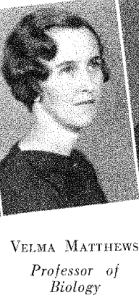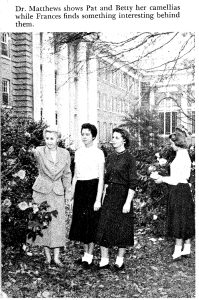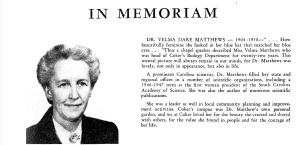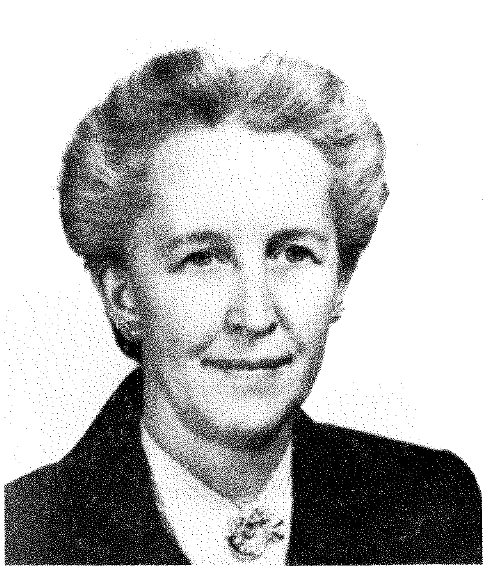(3 August 1904 – 7 January 1958)
Special thanks to Jonathan Garren, MLIS, MA, Outreach Librarian, Coker College for providing photographs for this post.

The University of North Carolina at Chapel Hill Herbarium (NCU) has cataloged about 400 vascular plants collected by Velma Dare Matthews. As we continue to catalog our collections it is likely that more will be found. NCU also curates about 20 macrofungi and a dozen bryophytes collected by Dr. Matthews.
Velma Dare Matthews was born in Burlington, Alamance County, North Carolina to Joseph Marvin Matthews (1878-1940) and Cora Daisy Moore Matthews (1882-1931). She grew up in High Point, Guilford County, North Carolina.1,3
She earned a B.A. from North Carolina College for Women (now University of North Carolina at Greensboro), then earned M.A. and Ph.D. at the University of North Carolina at Chapel Hill under the direction of Dr. William Chambers Coker. She was awarded the Smith Prize for Research (Science) at commencement in 1930.2

She began her teaching career in the Botany Department of Arkansas A & M College. In 1934 she moved to Coker College in Hartsville, South Carolina, and served as the chair of the Biology Department for twenty-two years, starting in 1935. “She was mainly responsible for making the Coker campus a showplace of camellias and azaleas. She also played a major role in planning and supervising construction of Coker’s million-dollar science building.”5 Dr. Matthews was the first woman to serve as the President of the South Carolina Academy of Science (1946-1947).3
While a graduate student in 1928, Ms. Matthews described a species of oomycete, Pythium papillatum V. D. Matthews. Oomycetes, commonly called “water molds”, were considered to be fungi until about the 1960’s. Matthews isolated this organism from soil collected in the Chapel Hill area in December, 1927 by fellow Carolina student, Andrew Clark Mathews.
“During the summer of 1935 the writer [Dr. Velma Dare Matthews] found a most unusual fungus growing on a small dead fly in a pool in a depression of a large rock on Bald Knob in Giles County, Virginia. The elevation at this point is about 4,200 feet. At this time only a few plants were observed and all attempts to culture the fungus proved in vain. However, in the summer of 1936 the same fungus was found growing on an insect in the same pool. This time the writer succeeded in growing the fungus on house fly eggs, which had just been removed from a fly and placed in sterile water. If the fly eggs were of the proper maturity an abundant group of plants usually grew on at least a few of the eggs, when they were placed in culture.” Dr. Matthews named a new genus, Blastocladiella, and a new species, Blastocladiella simplex, based on this fungus. In 2014 Matthew’s name was replaced with Clavochytridium simplex Doweld.4
In 1936 Dr. Matthews described a fungus she found growing on Huckleberry (Gaylussacia) and Shadbush (Amelanchier) fruits at Mountain Lake, Giles County, Virginia. Rhipidium compactum V. D. Matthews was published in the Journal of the Elisha Mitchell Scientific Society 52(2): 291-293.
She died at age 53 in Duke Hospital in Durham, Durham County, North Carolina on 7 January 1958 and is buried in Oakwood Memorial Park Cemetery in High Point, North Carolina.1,3

A prominent Carolina scientist, Dr. Matthews filled key state and regional offices in a number of scientific organizations, including a 1946-1947 term as the first women president of the South Carolina Academy of Science. She was also author of numerous scientific publications.
She was a leader as well in local community planning and improvement activities. Coker’s campus was Dr. Matthew’s own personal garden, and we at Coker loved her for the beauty she created and shared with others, for the value she found in people and for the courage of her life.”
PUBLICATIONS:
Matthews, Velma Dare. 1928. Nowakowskiella and a new species of Pythium. Journal of the Elisha Mitchell Scientific Society 43(3/4): 229-232.
Matthews, Velma Dare. 1932. The aquatic vegetation of Quaker Run. Journal of the Elisha Mitchell Scientific Society 47(1): 74-84.
Matthews, Velma D. 1935. Notes on some Oomycetes from the vicinity of Mountain Lake, Giles County, Virginia. Journal of the Elisha Mitchell Scientific Society 51(2): 306-310.
Matthews, Velma D. 1936. A new species of Rhipidium from Mountain Lake, Virginia. Journal of the Elisha Mitchell Scientific Society 52(2): 291-293.
Matthews, Velma D. 1937. A new genus of the Blastocladiaceae. Journal of the Elisha Mitchell Scientific Society 53(1): 191-195.
Matthews, Velma D. 1940. The ferns and fern allies of South Carolina. American Fern Journal 30(3): 73-80.
Matthews, Velma D. 1941. The ferns and fern allies of South Carolina (Conclusion). American Fern Journal 31(1): 4-12.
Couch, John N. and Velma D. Matthews. 1954. William Chambers Coker. Mycologia 46(3): 372-383.
SOURCES:
1. Velma Dare Matthews. Find A Grave Memorial #98433321. http://www.findagrave.com/cgi-bin/fg.cgi?page=gr&GRid=98433321 accessed on 5 February 2015.
2. One Hundred and Thirty-fifth Annual Commencement, Tuesday, June 10, 1930. University of North Carolina. https://archive.org/stream/commencement19301930univ/commencement19301930univ_djvu.txt
3. University of North Carolina at Chapel Hill, Alumni Records.
4. Index Fungorum. http://www.speciesfungorum.org/Names/NamesRecord.asp?RecordID=278188 accessed on 8 January 2023.
5. Dr. Velma Mathews, Nationally Known Biologist, Succombs. Durham Herald, 8 January 1957.
6. Personal communication, email to McCormick from Jonathan Garren, MLIS, MA. Outreach Librarian, Coker College.
